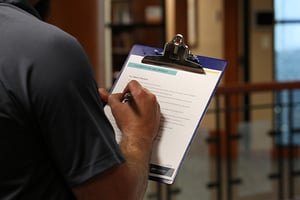It can be a overwhelming when the fire marshal requires you to provide a fire watch for your building. Fire watches are often misunderstood and are an underappreciated fire prevention technique. But truthfully, performing one is fairly simple and if organized properly, it should be painless.
Why would I need a fire watch?

A fire watch is usually required for one of four reasons:
- The building’s fire alarm, fire sprinkler, or fire suppression system is out of order or an outage is preplanned for a period to exceed four hours. The fire marshal often requires notification for conditions like these. *Check with your local AHJ (Authority Having Jurisdiction) for local requirements.
- Hot work is occurring in the building. Hot work includes welding, using a torch, or other spark or flame producing work. Many building fires have been ignited by activities considered hot work.
- During demolition of a building during certain hazardous activities similar to hot work.
- Dense crowds in a building requiring extra precautions. Some public assembly buildings are required to conduct fire watches during events for extra crowd protection.
How do I conduct a fire watch?
A fire watch consists of one or more qualified persons performing these functions:
- Keeping diligent watch for fires
- Preventing fire ignition sources
- Ensuring adequate means of egress and removing obstructions to egress as necessary
- Promptly remediating hazards that are found
- Being prepared to contact the fire department
- Being ready to extinguish any fires using a portable fire extinguisher or hose
- Warning the occupants of any hazardous conditions requiring evacuation
DOWNLOAD FIRE WATCH LOG AND CHECKLIST
How do I organize a fire watch?
It’s important to take the time to properly organize a fire watch. The fire watch should cover the building in a systematic manner on a recurring basis, usually covering the whole building every hour. The only exception is in the cases of hot work, then only the portion of the building exposed to the hazard would need to be watched. Part of being organized is keeping records of the fire watch occurring. For a useful form to use as part of your fire watch download our recommended form here.
Fire watch rules and enforcement vary between cities and enforcing officials, but in general for system outages something is going to be required. The other option is to vacate the building during an outage, but that is rarely a popular choice. But yes, if the fire marshal requires a fire watch, you’re going to have to do it.
When should a fire watch be terminated?
The answer depends on the reason for the watch. For system outages the watch can be finished after the affected system is restored to service. For hot work and construction-related watches the rule of thumb is the watch can be finished a half hour after the hot work is completed. For watches required during large crowd events the watch can be ceased after the event has ended and the crowd has left.
More useful information on fire watches can be found in the International Fire Code and NFPA 1, Fire Code.
For other questions about fire watches and what system outages might require one, you can contact us here.




